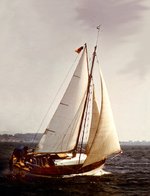Sailing ship
|
|
- For history of "sailing ship," see shipbuilding.
A sailing ship is a wind-powered ship. Historically, sailing ships were the primary means of transportation across long distances of water (e.g. rivers, lakes, oceans) before the invention of the first workable steam engines. They were used for carrying cargo, passengers, mail, supplies etc. In modern times sailing ships are less common but are still used in some parts of the world, such as the Indian Ocean, as commercial vessels. Small sailing boats are still used for fishing in developing countries. There are also many tall ship training vessels that provide recreational sailing.
Sailing ships were also used for military purposes, particularly in the age of sail. The Spanish convoys bringing back gold and silver from the newly discovered Americas needed protection from the pirates and privateers. Large sea battles were fought between the United Kingdom, France, Spain and the Netherlands.
There are many different types of sailing ships, but they all have certain basic things in common. Every sailing ship has a hull; rigging; at least one mast to hold up the sails that use the wind and power the ship. Ballast weighs down the bottom of the ship, so the wind does not push the ship over. At one time the convention was that only a vessel with three or more masts was called a "ship", a single or two-masted vessel being called a "boat", but little notice is now taken of this supposed rule.
Sailing-ship.jpg
The crew who sail a ship are called sailors or hands. They take turns to take the watch. Some sailing ships use traditional ship's bells to tell the time and regulate the watch system.
Ocean journeys by sailing ship can take many months, and a common hazard is becoming becalmed because of lack of wind, or being blown off course by severe storms. A severe storm could lead to shipwreck, and the loss of all hands.
Sailing ships can only carry a certain quantity of supplies in their hold, so they have to plan long voyages carefully to include many stops to take on provisions and especially fresh water.
The sailing ship was generally replaced by the steamship during the 19th century. The original reciprocating engine steam ships were in their turn replaced by ships with steam turbine and diesel engines. Today's cargo vessels are faster and more reliable than sailing ships, as they do not rely on sails or the vagaries of the wind. However, sailing ships are still in use in many parts of the world, both for pleasure and work.
Specific types of sailing vessels
A dizzying variety of names have been used, and many of them have changed in meaning over time.
- barque, or bark - at least three masts, fore-and-aft rigged mizzen mast
- barquentine
- bilander
- brig - two masts square rigged
- brigantine - two masts
- caravel
- carrack
- clipper
- cog - plank built, one mast, square rigged
- corvette
- cutter
- dhow
- dinghy - open, usually one mast
- frigate
- fluyt
- galleon
- hermaphrodite brig
- junk
- ketch - two masts, the mizzen mast forward of the rudder post
- longship
- schooner - fore-and-aft, two or more masts, after masts as tall as the main mast
- ship of the line - large warship, three masts (sometimes four) and a bowsprit
- sloop
- smack
- snow - two masts with trysail mast
- xebec
- yawl - two masts, the mizzen mast aft of the rudder post
See also
Template:Sailing vessels and rigs
- sailing (general notes on how to sail)
- rigging (history and pictures of large rigs)
- sail-plan (types of rigs, details of terminology)
- List of sailboat types
- sailing ship accidents
- ship's bells (description of the traditional watch system)
- Dynaschiffcs:Plachetnice
da:Sejlskib de:Segelschiff fr:Navire à voile nl:Zeilschip ja:帆船 no:Seilskip pl:Żaglowiec

